lock PONTIAC GRAND AM 1998 Owners Manual
[x] Cancel search | Manufacturer: PONTIAC, Model Year: 1998, Model line: GRAND AM, Model: PONTIAC GRAND AM 1998Pages: 370, PDF Size: 16.11 MB
Page 6 of 370
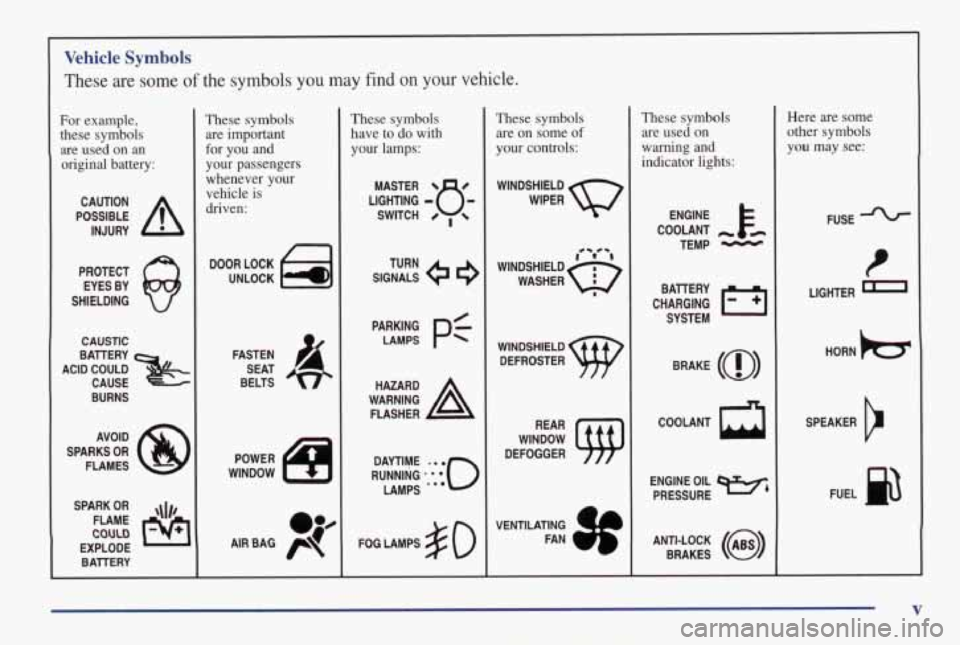
Vehicle Symbols
These are some of the symbols you may find on your vehicle.
For example,
these symbols
are used on an
original battery:
POSSIBLE A
CAUTION
INJURY
PROTECT EYES BY
SHIELDING
CAUSTlC
ACID COULD x
BAllERY
CAUSE
.~ .. ~
BURNS
AVOID
SPARKS
OR
FLAMES
FLAME
EXPLODE BAllERY
These symbols are important
for you and
your passengers
whenever your vehicle is
driven:
FASTEN
SEAT
BELTS
POWER
WINDOW
These symbols
have
to do with
your lamps:
SIGNALS 6
TURN
PARKING
PC
LAMPS
FOG LAMPS # 0
These symbols
are on some
of
your controls:
WINDSHIELD
DEFROSTER
WINDOW
DEFOGGER
VENTILATING
These symbols are used on
warning and
indicator lights:
COOLANT -
TEMP -
CHARGING I-1
BATTERY
SYSTEM
BRAKE
(a)
COOLANT a
ENGINE OIL w,
PRESSURE
ANTI-LOCK
(e)
BRAKES
Here are some
other symbols
you
may see:
FUSE
LIGHTER
n
HORN )tr
SPEAKER
b
FUEL p3
V
Page 9 of 370
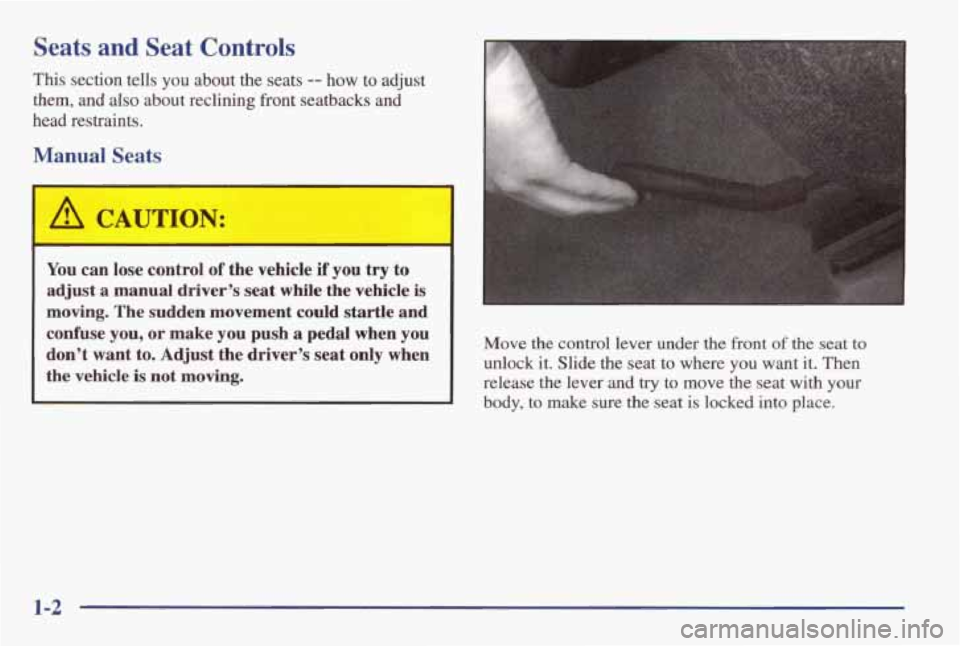
Seats and Seat Controls
This section tells you about the seats -- how to adjust
them,
and also about reclining front seatbacks and
head restraints.
Manual Seats
A CAUTION: I I
1
You can lose control of the vehicle if you try to
adjust a manual driver’s seat while the vehicle
is
moving. The sudden movement could startle and - I
confuse you, or make you push a pedal when you
don’t want to. Adjust the driver’s seat only when Move the control lever under the front of the seat to
unlock it. Slide the ‘seat to where you want it. Then the vehicle is not moving. release the lever and try to move the seat with your
I body, to make sure the seat is locked into place.
1-2
Page 11 of 370

REAR CONTROL (C): Raise the rear of the seat by
holding
the switch up. Lower the rear of the seat by
holding the switch down.
Reclining Front Seatbacks
+
A
I But don’t have a seatback reclined if your vehicle
is moving.
To adjust the seatback, lift the lever on the outer side of
the seat and move the seatback to where you want it.
Release the lever to lock the seatback. Pull
up on the
lever
and the seat will go to an upright position.
1-4
Page 13 of 370
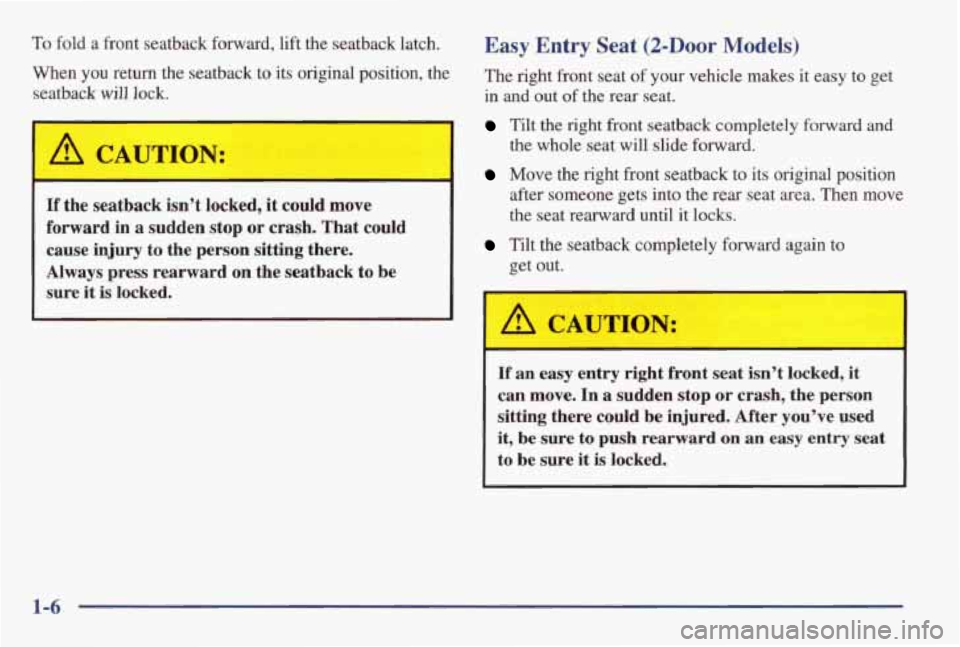
To fold a front seatback forward, lift the seatback latch.
When you return the seatback to its original position, the
seatback
will lock.
I A CAUTION:
I
I A CAUTION:
Easy Entry Seat (2-Door Models)
The right front seat of your vehicle makes it easy to get
in and out of the rear seat.
Tilt the right front seatback completely forward and
Move the right front seatback to its original position
the whole seat will slide forward.
after someone gets into
the rear seat area. Then
move
the seat rearward until it locks.
Tilt the seatback completely forward again to
get out.
If the seatback isn’t locked, it could move
forward in
a sudden stop or crash. That could
cause injury to the person sitting there.
Always press rearward on the seatback to be
sure it is locked.
If an easy entry right front seat isn’t locked, it
can move. In a sudden stop or crash, the person
sitting there could be injured. After you’ve used
it, be sure to
push rearward on an easy entry seat
to be sure it is locked.
1-6
Page 20 of 370
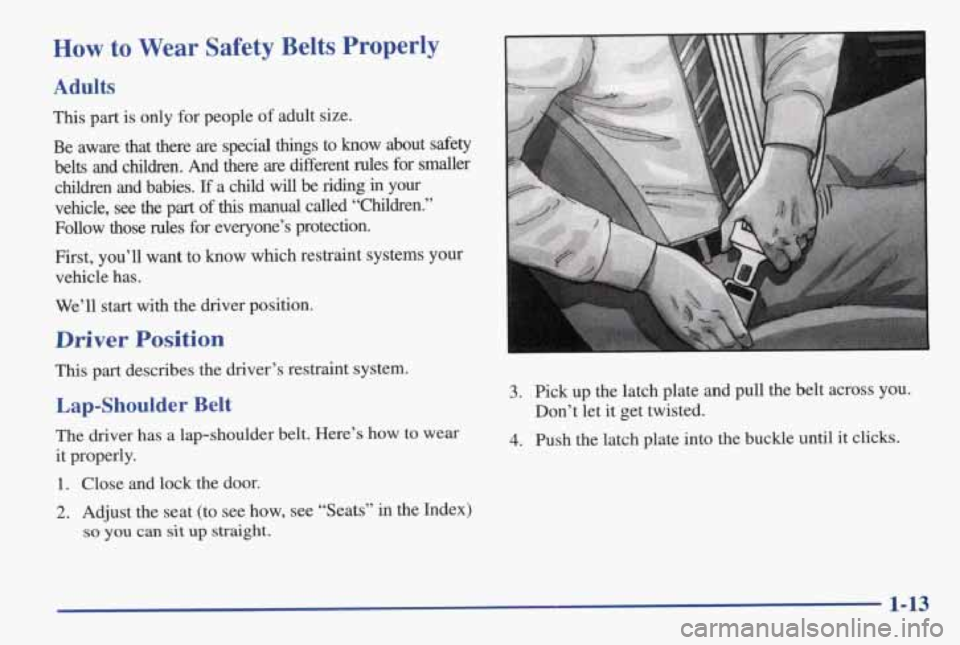
How to Wear Safety Belts Properly
Adults
This part is only for people of adult size.
Be aware
that there are special things to know about safety
belts and children. And there are Merent rules for smaller
children and babies. If a child will be riding in your
vehicle,
see the part of this manual called “Children.”
Follow those rules for everyone’s protection.
First, you’ll
want to know which restraint systems your
vehicle has.
We’ll
start with the driver position.
Driver Position
This part describes the driver’s restraint system.
Lap-Shoulder Belt
The driver has a lap-shoulder belt. Here’s how to wear
it properly.
1. Close and lock the door.
2. Adjust the seat (to see how, see “Seats” in the Index)\
so you can sit up straight.
3. Pick up the latch plate and pull the belt across you.
Don’t let it get twisted.
4. Push the latch plate into the buckle until it clicks.
1-13
Page 22 of 370

The lap part of the belt should be worn low and snug on
the hips, just touching the thighs.
In a crash, this applies
force to the strong pelvic bones. And you'd
be less likely
to slide under the lap belt.
If you slid under it, the belt
would apply force at your abdomen.
This could cause
serious or even fatal injuries. The shoulder belt should
go
over the shoulder and across the chest. These parts of the
body are best able to take belt restraining forces.
The safety belt
locks if there's a sudden stop or crash.
Shoulder Belt Height Adjuster (4-Door Models)
Before you begin to drive, move the shoulder belt
adjuster to the height that is right for you.
To move it down, squeeze
the release button and move
the adjuster
to the desired position. You can move the
adjuster up just by pushing up on the shoulder belt
guide. After you move the adjuster
to where you want it,
try to move it down without squeezing the release button
to make sure it has locked into position.
1-15
Page 37 of 370
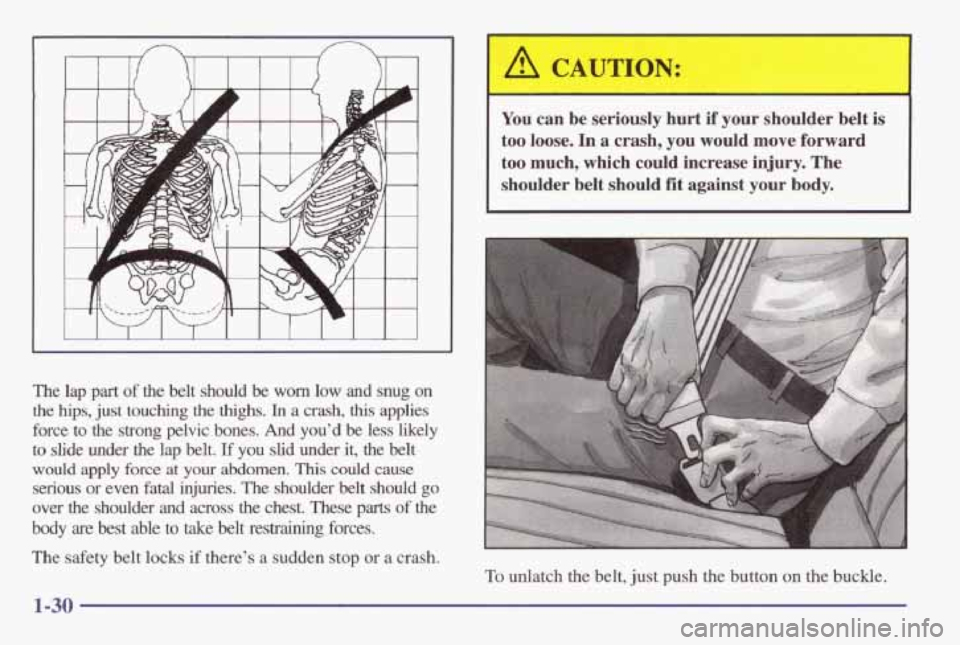
The lap part of the belt should be worn low and snug on
the hips, just touching the
thighs. In a crash, this applies
force
to the strong pelvic bones. And you’d be less likely
to slide under the lap belt. If you slid under it, the belt
would apply force at your abdomen. This could cause
serious or even fatal injuries. The shoulder belt should go
over the shoulder and across the chest. These parts of the
body are best able to take belt restraining forces.
r
You can be seriously hurt if your shoulder belt is
too loose.
In a crash, you would move forward
too much, which could increase injury. The
shoulder belt should
fit against your body.
The safety belt locks if there’s a sudden stop or a crash.
To unlatch the belt, just push the button on the buckle.
1-30
Page 62 of 370

v
Section 2 Features and Controls
Here you can learn about the many standard and optional featur\
es on your vehicle, and information on starting, shifting and braking.
Also explained are the instrument panel and the warning systems that tell you if everythmg is
working properly -- and what to do if you have a problem.
2-2
2-4
2-7
2-11
2- 12
2- 13
2- 14
2- 14
2-
16
2- 19
2-2 1
2-25
2-27
2-28
2-30
Keys
Door
Locks
Keyless Entry System
TrUnk
Theft
Passlock@
New Vehicle “Break-In’’
Ignition Positions Starting Your Engine
Engine Coolant Heater
(If Equipped)
Automatic Transaxle Operation
Manual Transaxle Operation
Parking Brake
Shifting Into PARK
(P)
(Automatic Transaxle Only)
Shifting Out of PARK(P)
(Automatic Transaxle Models
Only)
2-30
2-3
1
2-3 1
2-32
2-33
2-34 2-34
2-42
2-44
2-47 2-48
2-50
2-5 1
2-52
2-56
Parking Your Vehicle
(Manual Transaxle Only)
Parking Over Things That
Burn
Engine Exhaust Running Your Engine While You’re Parked
(Automatic Transaxle)
Windows
Tilt Wheel (If Equipped)
Turn SignaVMultifunction Lever
Exterior Lamps
Interior Lamps
Mirrors Storage Compartments
Accessory Power Outlet
Sunroof
(If Equipped)
The Instrument Panel --Your
Information System
Warning Lights, Gages
and Indicators
2-1
Page 64 of 370

One key is used for the
ignition, the
doors and all
other locks.
When a new Pontiac is delivered, the dealer removes the
tags
from the keys, and gives them to the first owner.
Each
tag has a code on it that tells your dealer or a
qualified locksmith how to make extra keys. Keep the
tags in a safe place. If you lose your keys, you’ll be able
to have new ones made easily using these tags.
If you need a new key, go to your Pontiac dealer for the
correct key code.
In an emergency, call the Poatiac
Roadside Assistance
Program at 1-800-ROADSIDE or
1-800-762-3743 (in Canada, call 1-800-268-6800).
NOTICE:
Your vehicle has a number of new features that
can help prevent theft, therefore, you
can have a
lot
of trouble getting into your vehicle if you ever
lock your keys inside.
You may even have to
damage
your vehicle to get in. So be sure you
have extra keys.
2-3
Page 65 of 370

Door Locks
a CAUTION:
Unlocked doors can be dangerous.
Passengers
-- especially children -- can easily
open the
doors and fall out. When a door is
locked, the inside handle won’t open it.
Outsiders can easily enter through an unlocked
door when you slow down or stop your vehicle.
This
may not be so obvious: You increase the
chance
of being thrown out of the vehicle in a
crash
if the doors aren’t locked. Wear safety belts
properly, lock your doors, and you will be far
better
off whenever you drive your vehicle.
There are several ways to lock and unlock your vehicle,
From the outside, you can use your key in the door lock.
You can also use the keyless entry system if your vehicle
has this option.
From the inside, you can lock the door by sliding the
locking lever rearward.
To unlock the door, slide the locking lever forward.
2-4